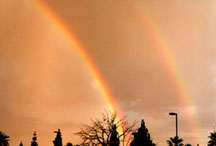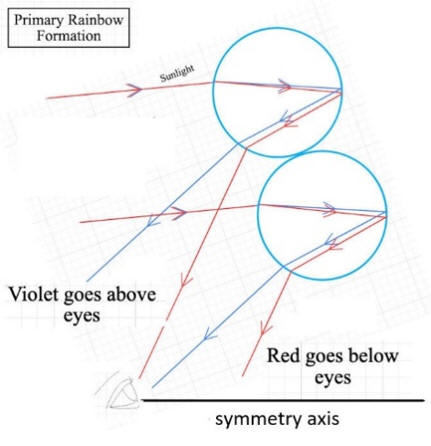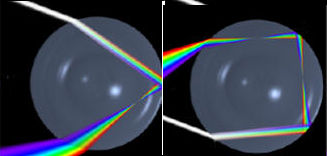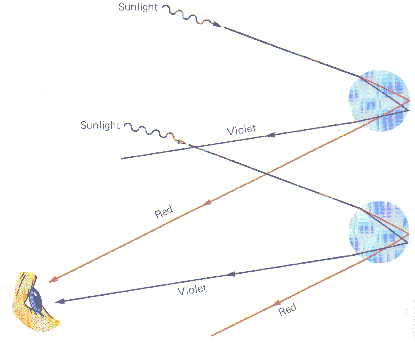 The velocity of light in a material, and hence the index of refraction of the
material, depends on the wavelength of the light. Since the refractive
index depends on the wavelength of the light, light waves with different
wavelengths and therefore different colors are refracted through
different angles. This is called dispersion, because white light
is dispersed into its component colors while traveling through the
material.
The velocity of light in a material, and hence the index of refraction of the
material, depends on the wavelength of the light. Since the refractive
index depends on the wavelength of the light, light waves with different
wavelengths and therefore different colors are refracted through
different angles. This is called dispersion, because white light
is dispersed into its component colors while traveling through the
material.
The index of refraction n of most materials transparent to visible light
increases slightly as the wavelength decreases.
As the index n increases
- the speed of light decreases,
- the wavelength of light in the material decreases,
- the angle of refraction θt decreases for a given θinisinθi
= ntsinθt , the light is bent more.
Snell's law combined with a wavelength-dependent index of refraction n
explains the dispersive properties of a prism. The sides of a prism are not
parallel and light changes direction when it passes through it.
A ~1% variation in the index of refraction over the entire visible range of
electromagnetic radiation still results in a significant change in the direction
of the emerging red and blue rays. Since in general the index of refraction is
bigger for shorter wavelengths, blue light bends more than red light.
Rainbows
A rainbow is produced by dispersion and internal reflection of light in water
droplets in the atmosphere. White light from the sun enters a spherical
raindrop. The different colors are refracted through different angles, reflected
off the back of the drop, and then refracted again when they emerge from the
drop. The white light now has been dispersed into its component colors, and the
different colors travel in slightly different directions. You see red light
coming from water droplets higher in the sky than violet light. The other colors
are found between these, making a rainbow. In the figure to the right and below, red light
arrives at the eye of the observer from the upper drop and violet light from the
lower drop. Other raindrops yield the other colors.
 Rainbows are usually seen as half circles. From a plane or from a very tall
building or mountain, however, one can see a complete circle.
Rainbows are usually seen as half circles. From a plane or from a very tall
building or mountain, however, one can see a complete circle.
 The
sunlight comes from a particular direction. If the angles are just right for
refraction, reflection and refraction, the light can be directed towards your
eye.
The
sunlight comes from a particular direction. If the angles are just right for
refraction, reflection and refraction, the light can be directed towards your
eye.
For red light, the angles are just right for drops higher up that for blue
light if you are looking towards the center of the rainbow. The different colors
are directed towards your eye by different drops at different heights. The red
rays make a larger angle with the symmetry axis that the blue rays.
This is also true if you rotate the picture about the symmetry axis. As an
extreme case, imagine the picture not depicting a vertical but a horizontal
plane. The sunlight still comes from the same direction, and the red rays still
make a larger angle with the symmetry axis that the blue rays. This is why we
see a bow, for any angle less than 90o we rotate about the symmetry
axis, different drops can reflect light of a given color at a given angle
towards our eyes. Of course, there must be drops, it must be raining in that
direction.
Sometimes one can
see a double rainbow. The second, dimmer, band, which is higher in the sky than
the first, comes from light reflected twice inside a raindrop. This reverses the
order of the colors in the second band.

 |
 |
| Single rainbow |
Double rainbow |
Problem:
At sunset, in which direction are you most likely to see a rainbow?
Solution:
- Reasoning:
The sun should be behind you, so you would most likely see a rainbow looking
approximately east.
Sunset rainbows are special. The sun's rays are nearly horizontal, so
the top of the rainbow is high in the sky. Because of scattering the
sunlight at sunset contains more red and less blue hues. Therefore the red
bands of the rainbow are emphasized and the blue bands are muted.
Additional information:
The
Physics Classroom: Refraction and the Ray Model of Light Lessons 4
 The velocity of light in a material, and hence the index of refraction of the
material, depends on the wavelength of the light. Since the refractive
index depends on the wavelength of the light, light waves with different
wavelengths and therefore different colors are refracted through
different angles. This is called dispersion, because white light
is dispersed into its component colors while traveling through the
material.
The velocity of light in a material, and hence the index of refraction of the
material, depends on the wavelength of the light. Since the refractive
index depends on the wavelength of the light, light waves with different
wavelengths and therefore different colors are refracted through
different angles. This is called dispersion, because white light
is dispersed into its component colors while traveling through the
material.
 Rainbows are usually seen as half circles. From a plane or from a very tall
building or mountain, however, one can see a complete circle.
Rainbows are usually seen as half circles. From a plane or from a very tall
building or mountain, however, one can see a complete circle.  The
sunlight comes from a particular direction. If the angles are just right for
refraction, reflection and refraction, the light can be directed towards your
eye.
The
sunlight comes from a particular direction. If the angles are just right for
refraction, reflection and refraction, the light can be directed towards your
eye.

